Main menu
Common skin conditions

NEWS
Join DermNet PRO
Read more
Quick links
Skin tension lines — extra information
Skin tension lines
Author: Dr Lachlan Byth, Resident Medical Officer, Ipswich Hospital, Ipswich, QLD, Australia. DermNet Editor in Chief: Adjunct A/Prof Amanda Oakley, Dermatologist, Hamilton, New Zealand. Copy edited by Gus Mitchell. September 2019.
Introduction
Different types
Clinical features
Relevance to surgery
Affected conditions
What are skin tension lines?
Skin tension lines represent a map of the direction in which the tension in the skin is maximal at different body sites, usually drawn on a diagram of the human body.
The best-known skin tension lines are the Langer lines, named for Karl Langer, who described them in 1861. These are also called cleavage lines because they were determined by piercing cadaver skin with an awl (a small pointed tool for piercing holes in leather) and observing the orientation of the resulting wound [1].
These lines have important implications for the design and placement of surgical incisions, as well as for the patterns of spread of some skin disorders.
Langer lines
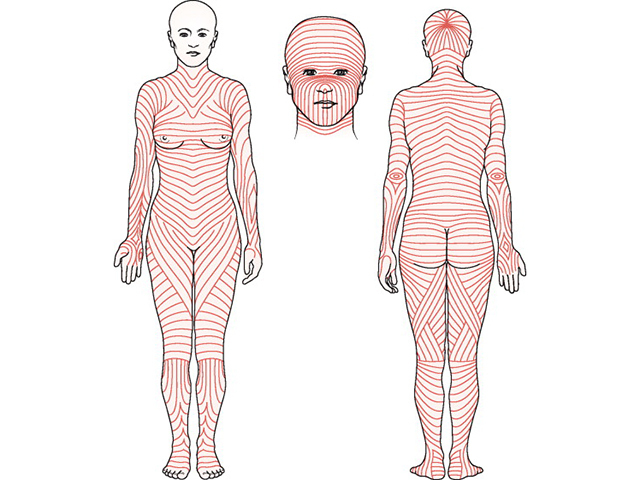
Skin tension lines
Credit. Newell K. Chapter 23. Wound closure. In: Dehn RW, Asprey DP (eds). Essential clinical procedures, 2nd edn. Philadelphia: Saunders, 2007.
What are the different types of skin tension lines?
There are several types of skin tension lines [1–3].
Cleavage lines
Cleavage lines include the Langer lines and other lines derived from similar experiments based on the shape of wounds.
Wrinkle lines
Wrinkle lines were described by Kraissl and were based on photographs of an elderly man with wrinkles [4]. Wrinkle lines do not always align with tension lines, particularly on the chin, dorsum of the nose, and the area lateral to the eyes.
Relaxed skin tension lines
Relaxed skin tension lines are produced in living subjects by positioning the body so that the skin is relaxed, and then gently pinching the skin to reveal a crease. These differ from the Langer lines, which were derived from cadavers — on the face, these two sets of lines often run at right angles to one another.
Biodynamic excisional skin tension lines
Biodynamic excisional skin tension (BEST) lines have been derived using tensiometer data (measure of muscle force) from patients undergoing skin excisions. These show the optimal orientation of a skin excision to minimise tension across its closure [5].
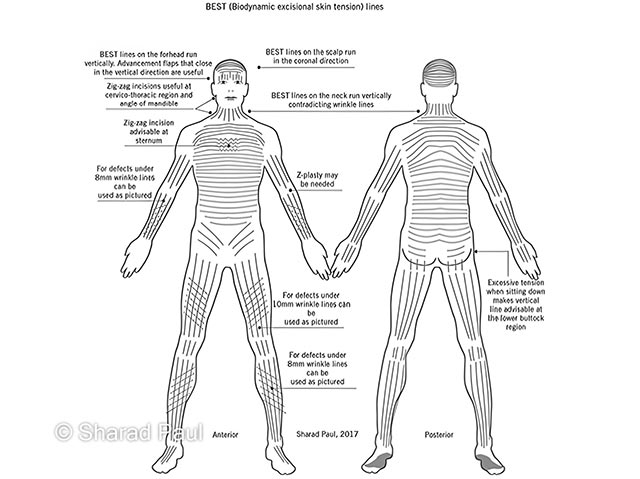
Biodynamic excisional skin tension lines (courtesy of Dr S Paul)
Why do skin tension lines exist?
Skin tension lines reflect internal tension within the skin and are mainly produced by the connective tissue of the dermis, superimposed by external tension.
The natural internal tension is derived from passive tension, particularly from collagen fibrils that become aligned in parallel to one another, and active tension from the contraction of fibroblast cells [5].
Skin tension lines differ from person to person and are affected by the protrusion of underlying bone, cartilage, and muscle, as well as by the movement of nearby joints [3].
When do skin tension lines matter in surgery?
Aligning a surgical incision or excision with skin tension lines results in minimal tension across the closure of the defect. This leads to optimal scar formation and minimises wound contraction.
The Langer lines were not intended as a guide for surgical excisions and they do not always correspond to the best orientation for these, often running perpendicular to skin folds. Relaxed skin tension lines, BEST lines, and lines following the direction of striae distensae (stretch marks) are more useful [5,7]. An incision placed along these lines will produce an inconspicuous scar.
As well as orienting the excision correctly, tension can be minimised by undermining (separating the superficial subcutaneous fat from the underlying soft tissue) and using relaxing incisions to distribute tension over a greater area.
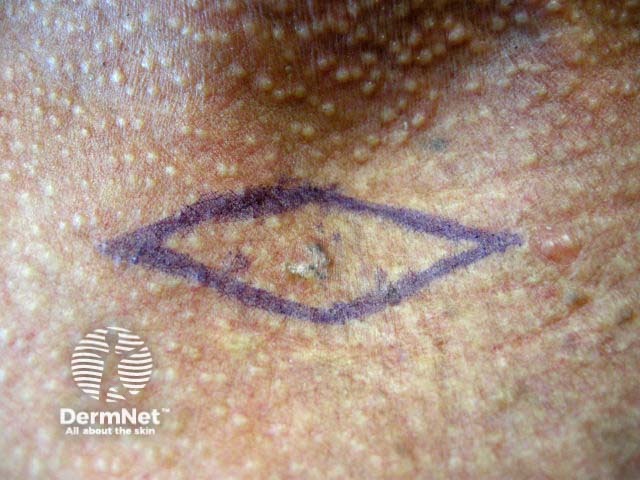
Excision selecting relaxed tension lines
What conditions are affected by skin tension lines?
Several skin disorders produce ovoid (egg-shaped) lesions on the back with their long axes aligned with skin tension lines [8]. This is called a 'Christmas tree pattern', and is seen in:
- Pityriasis rosea
- Mycosis fungoides
- Secondary syphilis
- Guttate psoriasis
- Kaposi sarcoma (exanthematic type)
- Eruptive seborrheic keratoses (the sign of Leser–Trélat)
- Wolf isotopic response (if following another skin disease in a Christmas tree pattern).
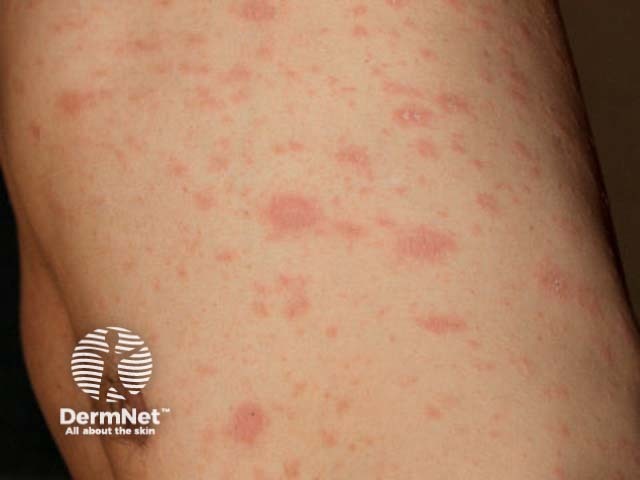
Pityriasis rosea
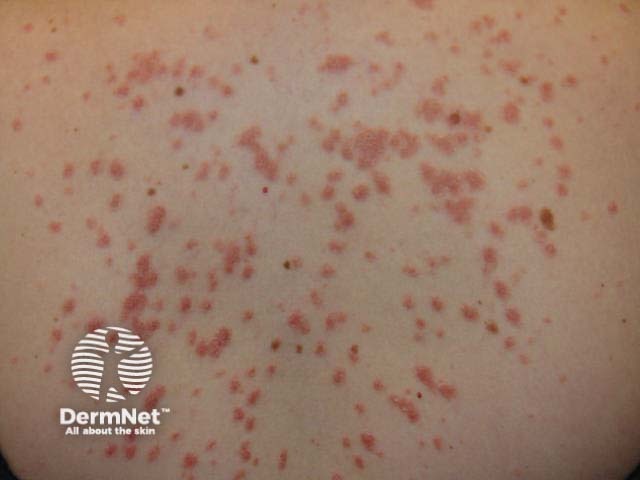
Guttate psoriasis
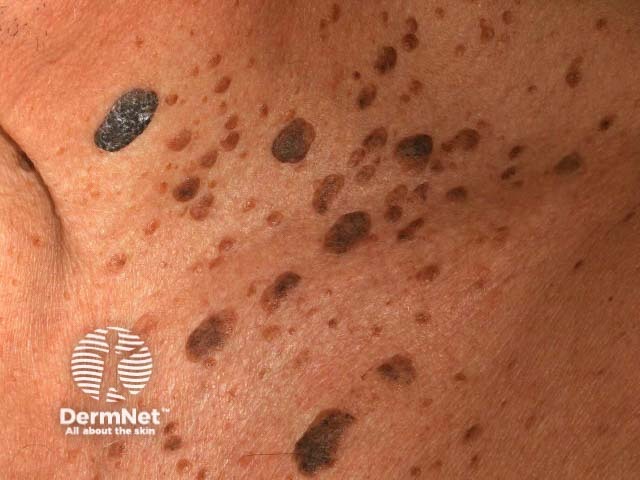
Seborrhoeic keratoses
Skin tension lines may also affect the spread of skin cancer.
Linear basal cell carcinoma is a morphological variant of basal cell carcinoma that generally follows relaxed skin tension lines. It presents as an elongated lesion often on the neck or around the eyes. Interactions between tumour cells and surrounding stroma may lead to preferential growth in the direction of these lines [9].
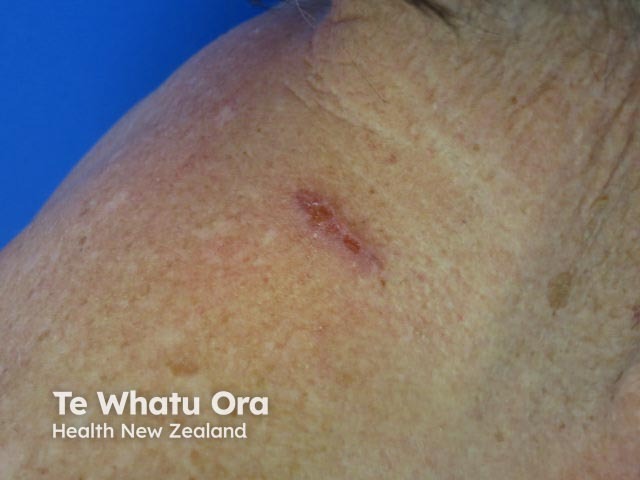
Linear basal cell carcinoma
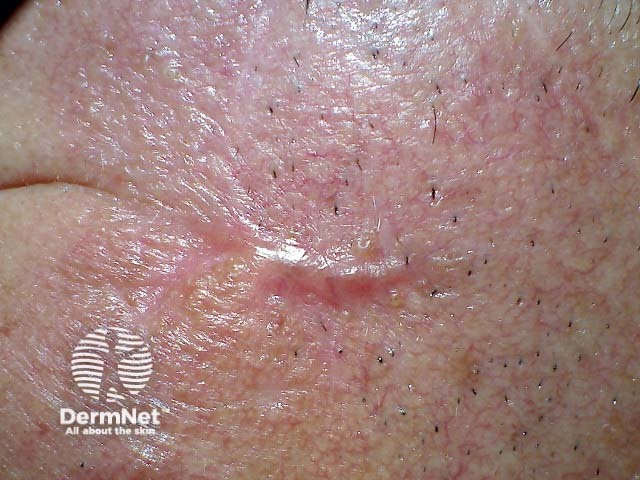
Linear basal cell carcinoma
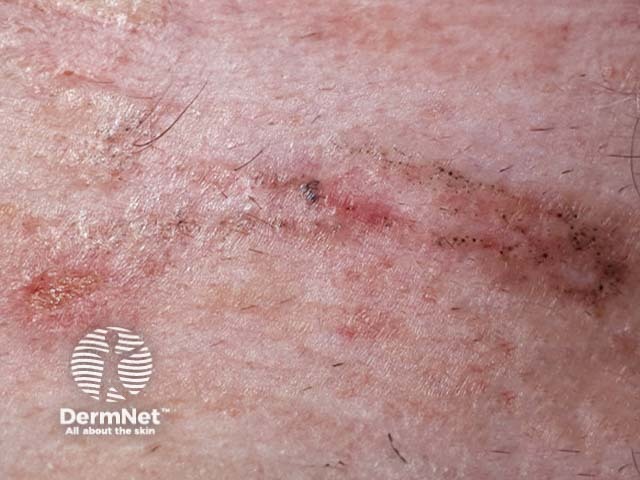
Linear pigmented basal cell carcinoma
References
- Hwang K. Revisiting the skin lines on the forehead and glabellar area. J Craniofac Surg. 2018; 29: 209–11. DOI: 10.1097/SCS.0000000000004073. PubMed
- Borges AF. Relaxed skin tension lines (RSTL) versus other skin lines. Plast Reconstr Surg. 1984; 73: 144–50. DOI: 10.1097/00006534-198401000-00036. PubMed
- Bush J, Ferguson MW, Mason T, McGrouther G. The dynamic rotation of Langer's lines on facial expression. J Plast Reconstr Aesthet Surg. 2007; 60: 393–9. DOI: 10.1016/j.bjps.2006.06.008. PubMed
- Kraissl CJ. The selection of appropriate lines for elective surgical incisions. Plast Reconstr Surg (1946) 1951; 8: 1–28. DOI: 10.1097/00006534-195107000-00001. PubMed
- Paul SP. Biodynamic excisional skin tension lines for surgical excisions: untangling the science. Ann R Coll Surg Engl. 2018; 100: 330–7. DOI: 10.1308/rcsann.2018.0038. PubMed
- Silver FH, Siperko LM, Seehra GP. Mechanobiology of force transduction in dermal tissue. Skin Res Technol. 2003; 9: 3–23. DOI: 10.1034/j.1600-0846.2003.00358.x. PubMed
- Lemperle G, Tenenhaus M, Knapp D, Lemperle SM. The direction of optimal skin incisions derived from striae distensae. Plast Reconstr Surg 2014; 134: 1424–34. DOI: 10.1097/01.prs.0000438462.13840.21. PubMed
- Wollenberg A, Eames T. Skin diseases following a Christmas tree pattern. Clin Dermatol 2011; 29: 189–94. DOI: 10.1016/j.clindermatol.2010.09.011. PubMed
- Lim KK, Randle HW, Roenigk RK, Brodland DG, Bernstein SC, Marcil I. Linear basal cell carcinoma: report of seventeen cases and review of the presentation and treatment. Dermatol Surg 1999; 25: 63–7. DOI: 10.1046/j.1524-4725.1999.08104.x. PubMed
On DermNet
Other websites
- Biodynamic excisional skin tension (BEST) lines — PubMed Central
